Fairfax Symphony Orchestra at George Mason University
By Stephen Brookes • The Washington Post • January 20, 2013
Watch out for Christopher Zimmerman. The music director of the Fairfax Symphony Orchestra has been injecting adrenaline into this small but determined ensemble since he took over in 2009. And the resulting performances — to judge by Saturday’s imaginative, high-octane concert at George Mason University’s Center for the Arts — have made the Fairfax players a serious force to be reckoned with.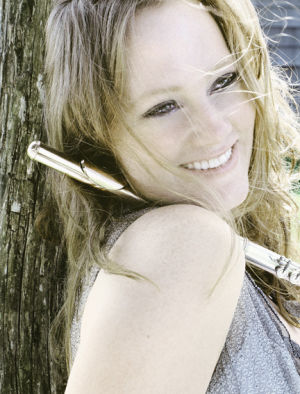 Christina JenningsTake the overture to Mozart’s “The Magic Flute,” which opened the program. Opened, actually, is too mild a word: The work shot out of the gate with so much heady momentum it blew your ears back. But there was no sacrifice of detail or elegance, either. Zimmerman conducts with a kind of coiled ferocity — you sensed he might pounce into the orchestra at any moment, to carry off the weak and slow — and the playing crackled with electricity and almost physical power.
Christina JenningsTake the overture to Mozart’s “The Magic Flute,” which opened the program. Opened, actually, is too mild a word: The work shot out of the gate with so much heady momentum it blew your ears back. But there was no sacrifice of detail or elegance, either. Zimmerman conducts with a kind of coiled ferocity — you sensed he might pounce into the orchestra at any moment, to carry off the weak and slow — and the playing crackled with electricity and almost physical power.
That, more or less, was the tone throughout the evening. Charles Ives’s contemplative “The Unanswered Question” received a beautifully nuanced performance, and the evening closed with a dramatic, big-boned account of Brahms’s Symphony No. 1, vividly drawn and riveting to its core. But for sheer sonic beauty, the high point was Jonathan Leshnoff’s Flute Concerto. Written just a few years ago, it’s a shimmering and absolutely beautiful work, awash in the iridescent colors and elegant savagery of French flute music of the early 20th century. Flutist Christina Jennings gave it a spirited, quicksilver performance, and Zimmerman brought a fine cinematic sweep to the orchestral side of things, with deft and detailed interplay between Jennings and the woodwinds. Leshnoff is clearly one of the more gifted young American composers around; kudos to the Fairfax players for showcasing his music.
Roll Over, Paganini: Here Comes Rachel Barton Pine
By Stephen Brookes • The Washington Post • January 19, 2013
Was Niccolo Paganini — that spectacular violin virtuoso of the early 19th century — the world’s first rock star?
The wild hair, the bad-boy mystique, the run-ins with the law, even the rumored devil worship — Paganini virtually invented the debauched-celebrity lifestyle, and lived it so intensely he makes modern rockers look like simpering ballerinas. He canceled sold-out concerts, led a depraved sex life (even after all his teeth were removed in 1828, he was still besieged by groupies), gambled away his money and perfected the gaunt, tormented-artist look — down to the all-black outfits he wore onstage. But Paganini was also one of the most influential musicians of his time, and a series of 24 “Caprices” for solo violin that he wrote between 1802 and 1817 are a landmark of the repertoire. They’re a tour de force of virtuosity — double-stopped trills, left-hand pizzicati, torrents of ricochets played at blinding speed — and Washington audiences will get a rare opportunity to hear all 24 next Sunday, in an unusual two-part concert by the violinist Rachel Barton Pine.
But Paganini was also one of the most influential musicians of his time, and a series of 24 “Caprices” for solo violin that he wrote between 1802 and 1817 are a landmark of the repertoire. They’re a tour de force of virtuosity — double-stopped trills, left-hand pizzicati, torrents of ricochets played at blinding speed — and Washington audiences will get a rare opportunity to hear all 24 next Sunday, in an unusual two-part concert by the violinist Rachel Barton Pine.
Pine brings an intriguing perspective to Paganini. At 38, she’s a fixture of the international concert circuit, and has been garnering rave reviews for her interpretations of everything from Mendelssohn to Chausson; her 2003 recording of the Brahms and Joachim concertos with the Chicago Symphony Orchestra won a Grammy nomination.
But she’s also one of the more adventurous violinists around, and every month or so she swaps her concert gown for a leather corset, trades her 1742 Guarneri for a solid-body electric violin, and joins Earthen Grave — her thrash/doom heavy metal band — for hard-driving, head-banging shows in Chicago’s late-night club scene.
Which, of course, provokes the irresistible question: If Paganini were alive today, would he be playing shred violin in a thrash band?
“Hard to say!” says Pine, laughing over the phone from her home in Chicago. “Paganini’s Caprices have influenced all the great metal guitarists — many of them are great classical fans themselves — so if there’s one classical concert that metal-heads are going to love, it would be this one.”
But for Pine, the sensationalism of Paganini’s life is only part of the picture. The violinist had a more generous side, she says, and composed in a style that was more Italian bel canto than full-throttle romanticism. True, the Caprices deliver plenty of raw firepower — but their real beauty, she says, comes from their lush melodic writing, their complex counterpoint, and the vivid, unusual colors they evoke.
“His music is supposed to be played with a lightness, a gracefulness, a delicacy that you often don’t hear,” says Pine, whose performance will combine commentary about the works with their actual playing. “The crash-and-burn, muscular style is not how Paganini would have played his own music — it’s really a very refined and elegant style.”
Pine’s fascination with the Caprices goes back to her early childhood, when her mother would play Itzhak Perlman’s classic recording as a reward for her good behavior. Pine was already a budding violinist by then; after hearing her first violin concert at the age of 3, she had begged her parents for lessons and became, as she puts it, “a little obsessed” with the instrument. “By the time I was 5,” she says, “I was signing my school papers, ‘Rachel, violinist.’ It was my whole being.”
It quickly became clear that she was extraordinarily gifted. She made her professional debut at the age of 7, playing Haydn’s Violin Concerto in G Major with the Chicago String Ensemble, and at 10 was a soloist with the Chicago Symphony Orchestra. Home-schooled, she practiced eight hours a day, and listened to heavy metal at night to relax. By the age of 15 she had performed with over 50 orchestras, and her career was underway.
But it was a constant struggle — not just to play, but to survive.
“Our life was a little tenuous,” she says. “My father was unemployed for most of my childhood. Our electricity and phone were getting shut off, and we were always one step away from losing the roof over our heads.” She relied on scholarships and borrowed instruments, and even the clothes she performed in had to be scrounged. “We would go to the thrift store, buy old bridesmaids’ dresses and fix them up,” she says. Niccolo PaganiniHer father eventually left for good, leaving Pine and her two younger sisters to be raised by their mother. But by 15, she was successful enough to become the family’s primary breadwinner, and two years later she entered the international concert circuit — where she promptly won the gold medal at the Johann Sebastian Bach International Competition, becoming the youngest person (and the first American) ever to do so. More prizes followed at competitions in Genoa (where she won the Paganini Caprice Prize), Brussels, Vienna, Budapest and Montreal, and in 1994 she released her first album, “Homage to Sarasate.”
Niccolo PaganiniHer father eventually left for good, leaving Pine and her two younger sisters to be raised by their mother. But by 15, she was successful enough to become the family’s primary breadwinner, and two years later she entered the international concert circuit — where she promptly won the gold medal at the Johann Sebastian Bach International Competition, becoming the youngest person (and the first American) ever to do so. More prizes followed at competitions in Genoa (where she won the Paganini Caprice Prize), Brussels, Vienna, Budapest and Montreal, and in 1994 she released her first album, “Homage to Sarasate.”
But just as her career was starting to soar, disaster struck. Getting off a commuter train outside Chicago on a cold January morning in 1995, Pine became trapped when the doors closed on her violin, which was strapped over her shoulder. Pinned to the train, she pounded on the doors and yelled for help, but the train began to move forward — dragging her more than 300 feet before pulling her under its wheels, severing her left leg and mangling the other. She was 20 years old.
The horrific accident nearly killed her, and seemed likely to destroy her career. For months she couldn’t even sit up in bed, let alone play, and for two years she was unable to travel or compete. Recovery was slow and excruciatingly painful — she endured dozens of surgeries over the next 14 years — and it was almost 10 years before she could walk again without crutches. But she fought her way back — with a little help, she says, from Paganini.
“I’d always had this dream of playing the 24 Caprices,” says Pine. “But I thought I would have to take a sabbatical and devote myself to them, training to do all these diverse techniques at a high level simultaneously, and then being able to last from beginning to end without fainting.” As she recuperated after the accident, the Caprices seemed increasingly out of reach. But then she met Greg Pine, a former minor-league pitcher (and now her husband) who pushed her to take on the challenge.
“He kept nagging me and nagging me,” she says. “So I finally said, ‘Okay, I’ll start practicing and see what happens. What do I have to lose?’”
What, indeed. In the 18 years since her accident, Pine has picked up her career with a vengeance. She’s performed as a soloist with conductors from Charles Dutoit to Marin Alsop, launched the Rachel Elizabeth Barton Foundation to help struggling musicians and released more than a dozen albums, from concertos and baroque chamber music to heavy metal. She’s been a torch-bearer at the Olympics, performed with Led Zeppelin’s Jimmy Page, played the national anthem at Chicago Bulls games, and collaborated with such rising young composers as Mohammed Fairouz. And physically — while she’ll always face some physical restrictions — she no longer needs the braces she used as recently as 2008, when she last appeared at the National Gallery of Art.
Then there’s Sylvia, her 16-month-old daughter, who’s been traveling with Pine since she was 3 weeks old, and has inspired the violinist’s next album: a collection of lullabies to be released this year. And how does Sylvia feel about Paganini — does she share her mother’s love of the 24 Caprices?
“Well, she’ll be in Washington with me for the concert,” says Pine, laughing. “She has to follow her food.”
Rachel Barton Pine will be performing Nicolo Paganini’s “24 Caprices” in a two-part concert on Jan. 27. The first 12 Caprices will be performed at 4 p.m. at the Phillips Collection (where Eugene Delacroix’s portrait of Paganini will be on view); tickets are $20. The second 12 will be played at 6:30 p.m. in the West Garden Court of the National Gallery of Art. Admission is free.
The JACK Quartet at Wolf Trap
By Stephen Brookes • The Washington Post • January 13, 2013
When it comes to cutting-edge music, the young virtuosos of the JACK String Quartet don’t shrink from much. They’re renowned for their fearless embrace of even the thorniest new works, and their performance of the complete quartets of Iannis Xenakis a couple of years ago in Baltimore was one of the most ear-changing, tour-de-force chamber music concerts of the year. So when the group arrived at the Barns at Wolf Trap on Friday night (with clarinetist and composer Derek Bermel), it promised to be — to say the least — a provocative event.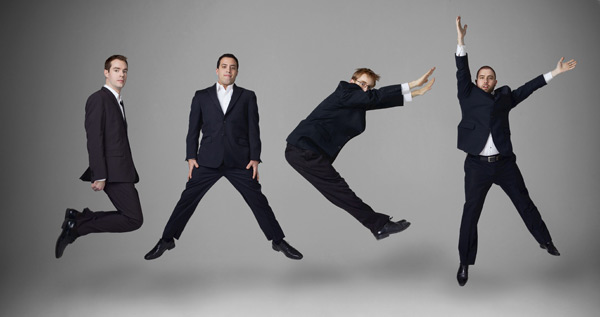 The evening opened with one of the great modernist masterpieces of the 20th century, the beautifully austere Quartet No. 2 by Gyorgi Ligeti. Dating from 1968, it’s built almost entirely from textures, delicate fragments of sound and sudden, explosive contrasts — and with few familiar handholds, it’s not an easy work. But the JACK players brought it off with compelling naturalness, as if it were crystallizing out of thin air: a subtle performance with a strange and almost otherworldly lyricism.
The evening opened with one of the great modernist masterpieces of the 20th century, the beautifully austere Quartet No. 2 by Gyorgi Ligeti. Dating from 1968, it’s built almost entirely from textures, delicate fragments of sound and sudden, explosive contrasts — and with few familiar handholds, it’s not an easy work. But the JACK players brought it off with compelling naturalness, as if it were crystallizing out of thin air: a subtle performance with a strange and almost otherworldly lyricism.
Derek Bermel’s “A Short History of the Universe” — a clarinet quintet receiving its world premiere — could not have been more different. As artist-in-residence at Princeton’s Institute for Advanced Study, Bermel has been studying gravitational physics and string theory and applying them to music. Uh-oh, you might think; but in fact, “History” proved to be a surprisingly playful work, from the rubbery glissandos of the opening “multiverse” to the songlike “heart of space” (imagine a Schubert-inflected Middle Eastern bluesy dirge) and the jaunty dance and hymn-like close of “twistor scattering,” in which “A Mighty Fortress is Our God” seemed to echo faintly through a slightly demented cosmos. All that freewheeling postmodernism made for an engaging, extremely enjoyable listen — an intriguing new work from a very 21st-century composer.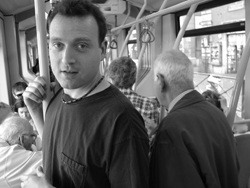 Derek BermelJohannes Brahms’ Clarinet Quintet in B minor, Op. 115, closed out the evening. It’s a magnificent work, but unfortunately the ensemble never seemed to get completely on top of it. While Bermel has a distinctive and thoughtful sense of phrasing, his clarinet tone has a bit of an edge to it, and the work felt labored all the way through, never achieving the effortless, golden Brahmsian glow that can make this work one of the most beautiful things on the planet to hear.
Derek BermelJohannes Brahms’ Clarinet Quintet in B minor, Op. 115, closed out the evening. It’s a magnificent work, but unfortunately the ensemble never seemed to get completely on top of it. While Bermel has a distinctive and thoughtful sense of phrasing, his clarinet tone has a bit of an edge to it, and the work felt labored all the way through, never achieving the effortless, golden Brahmsian glow that can make this work one of the most beautiful things on the planet to hear.
A Munch Celebration at the National Gallery of Art
By Stephen Brookes • The Washington Post • January 7, 2013
Gather together Norway’s most famous cultural figures from the past 200 years, and you won’t, in all honesty, have a huge crowd. There’s the painter Edvard Munch, of course, as well as the composer Edvard Grieg, the playwright Henrik Ibsen and (stretching a bit) the 19th century violinist Ole Bull. But what they lack in numbers they make up for in brilliance, and the work of all four was brought together for a fascinating concert at the National Gallery of Art on Sunday night, to launch the 150th anniversary celebration of Munch’s birth. Much of the evening was devoted, as you might expect, to Grieg. Soprano Tone Elisabeth Braaten sang five of the composer’s relentlessly lovely songs, from “En Fuglevise” (A Birdsong), with its playful, beguiling lyrics by Ibsen, to the much-loved “Solveig’s Song” from “Peer Gynt.” Braaten has a clear if not particularly big voice — more human-scaled than operatic — and she probed into the music with thoughtfulness and style, accompanied in turns by Stephen Ackert at the piano and members of the National Gallery of Art Orchestra. The fine Norwegian violinist Per Kristian Skalstad gave a heartfelt reading of Ole Bull’s richly romantic “Afsked” (Farewell) — a work sketched on a napkin and forgotten for 50 years before being resurrected — and led the orchestra in a delicate and wonderfully detailed account of Grieg’s famous “Anitra’s Dance.”
Much of the evening was devoted, as you might expect, to Grieg. Soprano Tone Elisabeth Braaten sang five of the composer’s relentlessly lovely songs, from “En Fuglevise” (A Birdsong), with its playful, beguiling lyrics by Ibsen, to the much-loved “Solveig’s Song” from “Peer Gynt.” Braaten has a clear if not particularly big voice — more human-scaled than operatic — and she probed into the music with thoughtfulness and style, accompanied in turns by Stephen Ackert at the piano and members of the National Gallery of Art Orchestra. The fine Norwegian violinist Per Kristian Skalstad gave a heartfelt reading of Ole Bull’s richly romantic “Afsked” (Farewell) — a work sketched on a napkin and forgotten for 50 years before being resurrected — and led the orchestra in a delicate and wonderfully detailed account of Grieg’s famous “Anitra’s Dance.”
But the real focus of the concert was the world premiere of Kjell Habbestad’s “Munch Suite,” a sort of multimedia flute concerto that explores the painter’s dark, expressionist and still-controversial work. As a selection of Munch’s paintings (often with phrases from his writings superimposed) were projected overhead, the orchestra interpreted the searing colors and complex visual rhythms, while the flute — that silvery voice of the psyche — danced above it in a kind of running commentary. It was fascinating to hear; Habbestad has a fine musical imagination, and the piece has a luminous, impressionistic quality to it that added new depths to the paintings. But the many narrative voices at play in the work — the clumsy zooming and panning over the paintings, the written phrases unfurling on the screen, the darting flute and the complex orchestral music — often seemed to be competing for attention rather than working together as a unified whole; a less “busy” visual approach might have focused the impact more powerfully.
Anthony Braxton at the Terrace Theater
By Stephen Brookes • The Washington Post • December 16, 2012
Is there any composer on the planet more wonderfully enigmatic than Anthony Braxton? Jazz saxophonist, ecstatic mystic, academic theorist, certified MacArthur “genius,” all-around American original — call him what you want, Braxton brought his Diamond Curtain Wall Quartet to the Terrace Theater on Saturday night for an extended set of some of the most inventive, maddening and impossible-to-pigeonhole music heard at the Kennedy Center in some time.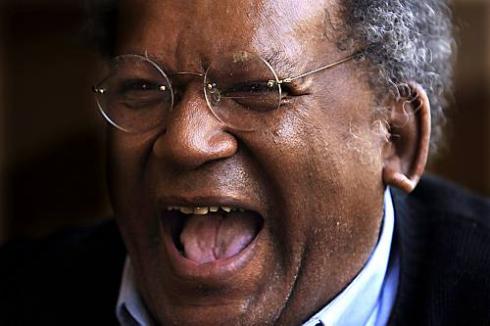 Braxton, of course, has been punching at the edges of new music since the late 1960s, and at age 67 he shows no sign of letting up. His music makes few concessions to comfort; neither jazz nor classical, it’s rooted in an almost impenetrable theoretical framework, and even the cryptic titles — such as “Composition #367F plus #241,” which made up Saturday’s entire 80-minute program — make the average ear curl up in alarm. But it’s also music of extraordinary vitality and a kind of seductive, cerebral beauty, marrying the anything-goes language of free jazz with the complex structures of the more — forgive the term — “serious” world of classical music.
Braxton, of course, has been punching at the edges of new music since the late 1960s, and at age 67 he shows no sign of letting up. His music makes few concessions to comfort; neither jazz nor classical, it’s rooted in an almost impenetrable theoretical framework, and even the cryptic titles — such as “Composition #367F plus #241,” which made up Saturday’s entire 80-minute program — make the average ear curl up in alarm. But it’s also music of extraordinary vitality and a kind of seductive, cerebral beauty, marrying the anything-goes language of free jazz with the complex structures of the more — forgive the term — “serious” world of classical music.
And, demanding as it was, “Composition” was a gorgeous work. Wildly colorful if often daunting on the surface, it held together with seamless musical logic, a cascade of ideas that seemed to well up and evolve with effortless spontaneity. Over a base of sustained electronic tones, Braxton and the three young virtuosos of his quartet (joined by the Kennedy Center’s Jason Moran at the piano) built fragments of intensely detailed sound — animalistic roars, delicate filigrees, sudden driving attacks, breathy fragments of melody, amplified scratches — into ever more complex textures, building layer upon layer until the momentum of the piece kicked in and it began to flow with the unstoppable fluidity and power of a river. Was it enigmatic? Absolutely — and beautifully so. Forget pigeonholes: This was music as complex and un-categorizable as life itself.
Fine Arts Quartet at the Kennedy Center
By Stephen Brookes • The Washington Post • December 12, 2012
Put together a list of the world’s most enduring string quartets, and the Fine Arts Quartet — a powerhouse of American chamber music for more than six decades — will rank very near the top. That’s due to the group’s incisive powers of interpretation and a taste for off-the-beaten-path repertoire, both of which were in evidence (if not always at the same time) Tuesday night, when the quartet appeared at the Terrace Theater at the Kennedy Center as part of the Fortas Chamber Music series.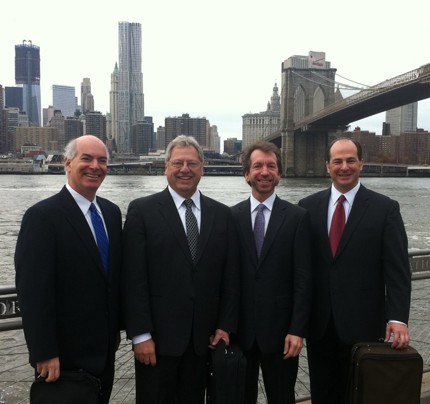 The program followed the usual quartet concert formula — open with Haydn, insert an unfamiliar work, close with a romantic blockbuster — but it’s a pattern that works. Haydn’s Quartet in G Major, Op. 77, No. 1 is a fascinating work, shimmering deftly from light to dark to light again, propelled by a tightly coiled logic underneath. To these ears, Haydn is best served slightly chilled, but the Fine Arts players took a warmer and more emotive approach — almost romantic, in fact, with little sobs tossed in here and there — that set the tone for the evening.
The program followed the usual quartet concert formula — open with Haydn, insert an unfamiliar work, close with a romantic blockbuster — but it’s a pattern that works. Haydn’s Quartet in G Major, Op. 77, No. 1 is a fascinating work, shimmering deftly from light to dark to light again, propelled by a tightly coiled logic underneath. To these ears, Haydn is best served slightly chilled, but the Fine Arts players took a warmer and more emotive approach — almost romantic, in fact, with little sobs tossed in here and there — that set the tone for the evening.
More intriguing was a little-known quartet by the violinist Efrem Zimbalist, more popularly known as the father of television star Efrem Zimbalist Jr. and grandfather of actress Stephanie Zimbalist. His Quartet in E Minor, written in 1931 and revised in 1959, is a lush and richly melodic work, romantic in style and Russian in flavor, that unfolds inventively and with the free sense of a fantasia. The Fine Arts Quartet brought great conviction to the work, and there was much to admire. But Zimbalist’s gift for melody was not always matched by a sense of the deeper architecture of music, and the work often felt taped together — a dated, fading snapshot of the times.
But Schubert’s Quartet No. 14 in D Minor — the famous “Death and the Maiden” quartet — remains as defiantly alive now as it was in 1824. It’s a thrilling work, and the Fine Arts Players turned in a superb and absolutely impassioned performance — a seamless and astute reading from its slashing opening chords to its galloping, heart-racing finale.
Eclipse Chamber Orchestra at the Masonic Memorial
By Stephen Brookes • The Washington Post • December 10, 2012
The early 18th century was a great time to be alive, if you happened to love music. Not only was Johann Sebastian Bach churning out one masterpiece after another, but a dozen other top-notch composers — from Handel to Vivaldi to Telemann — were all thriving as well, generating what cellist David Teie of the Eclipse Chamber Orchestra calls a “firestorm” of creative energy. Johann Sebastian BachThe extraordinary music that resulted was the subject of a fascinating concert on Sunday afternoon by the Eclipse players — a group largely made up of musicians from the National Symphony Orchestra — at the George Washington Masonic Memorial in Alexandria. Narrowing its focus to the concerto grosso form, in which small groups of soloists are pitted against a larger orchestra, the ensemble contrasted Vivaldi’s relatively light, open style with the harmonic complexity and densely woven counterpoint of Bach — and showed both off to elegant advantage.
Johann Sebastian BachThe extraordinary music that resulted was the subject of a fascinating concert on Sunday afternoon by the Eclipse players — a group largely made up of musicians from the National Symphony Orchestra — at the George Washington Masonic Memorial in Alexandria. Narrowing its focus to the concerto grosso form, in which small groups of soloists are pitted against a larger orchestra, the ensemble contrasted Vivaldi’s relatively light, open style with the harmonic complexity and densely woven counterpoint of Bach — and showed both off to elegant advantage.
It’s always a pleasure to hear the NSO players in solo roles, and Vivaldi’s Concerto for Two Flutes in C, RV 533, which opened the program, received a lighthearted and completely charming performance from Carole Bean and Alice Kogan Weinreb, who wove their melodic lines together in a kind of affectionate, playful echoing of each other. Even more satisfying was Bach’s Concerto for Oboe and Violin in C Minor, with Nicholas Stovall and Elisabeth Adkins on oboe and violin, respectively; the two showed how profound and emotionally complex the concerto grosso form could be. Stovall has a gorgeous tone (think chocolate with a little honey in it), and he and Adkins navigated Bach’s tightly argued counterpoint deftly and with convincing authority; a beautiful, captivating performance in every way.
Equally impressive was the orchestra, which played with extraordinary precision and cohesion despite the lack of a conductor. In fact, the only out-of-place note in the afternoon came after intermission, when harpsichordist William Neil switched to the organ for the “Offertoire Sur les Grands Jeux” by Francois Couperin. It’s a masterpiece of the baroque, and Neil brought it off with admirable power. But the heavy sound of the organ felt jarring in this otherwise delicately detailed program, as if an elephant had lumbered into the room and was tearing up the violins.
But things quickly got back on track with Vivaldi’s Concerto for Violin and Cello in B-flat Minor, RV547, thanks to eloquent, thoughtful playing from Teie and violinist Heather LeDoux Green (who seemed to float skyward at times from the sheer beauty of the music). But it may have been the closing work of the afternoon, Bach’s Brandenburg Concerto No. 3 in G, BWV 1048, that was the most intriguing. It’s a constantly shifting, wonderfully protean work where you’re never quite sure which of the nine soloists are in the foreground, and which in the background. The Eclipse players brought it off in a deeply integrated performance, full of subtle nuances and great beauty.

